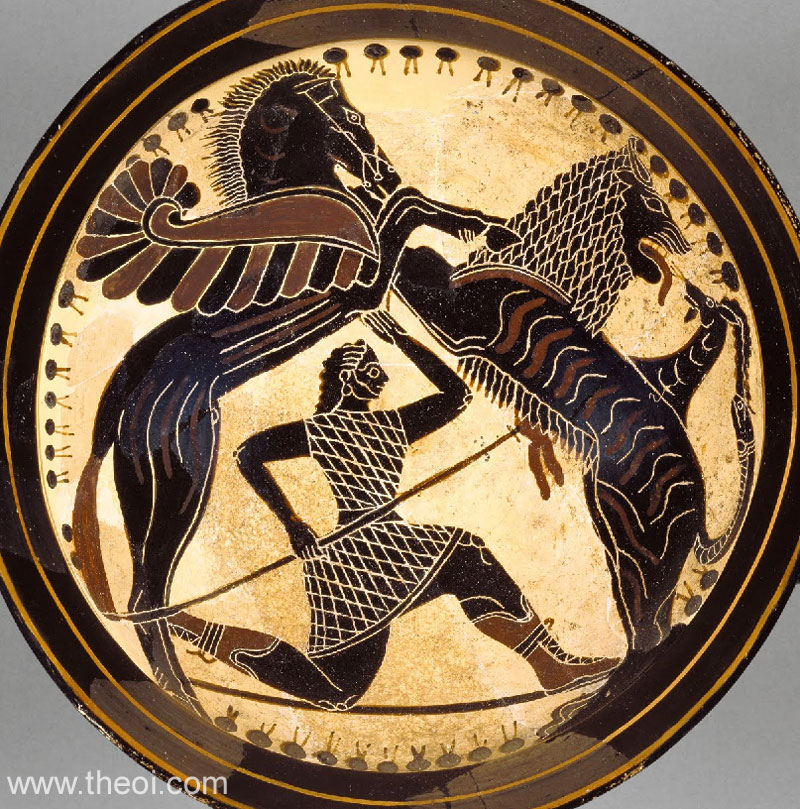Hellenic mythology has its fair share of mythological creatures. In general, they are considered challenges for the hero to overcome, and the Chimera (Khimaira, Χιμαιρα) is one of them. It features heavily in the story of Bellerophon.
In general, monsters beget monsters. In the case of the Chimera, it was mothered by Erchidna, half Nymph, half snake. The Chimera itself is described as a composite creature, with the body and maned head of a lion, a goat's head rising from its back, a set of goat-udders, and a serpentine tail. From Hesiod's Theogony:
"And there she has a cave deep down under a hollow rock far from the deathless gods and mortal men. There, then, did the gods appoint her a glorious house to dwell in: and she keeps guard in Arima beneath the earth, grim Echidna, a nymph who dies not nor grows old all her days.
As said before, the Chimera's main accomplishment if being felled by Bellerophon (Βελλεροφων), a mighty hero who was a son of the Corinthian king, Glaucus and Eurymede, and a grandson of Sisyphus. Alternatively, he was a son of Poseidon and Eurymede. In punishment, Bellerophon was told to slay the Chimera. What crime he committed differs along stories; in some, he is punished for committing murders and this quest is his purification, in others, he is being set up to die, and in a others again, he is falsely accused of trying to seduce or assaulting a married woman.
Hyginus in his 'Astronomica' speaks of the latter of events that led up to the dead of the Chimera:
In general, monsters beget monsters. In the case of the Chimera, it was mothered by Erchidna, half Nymph, half snake. The Chimera itself is described as a composite creature, with the body and maned head of a lion, a goat's head rising from its back, a set of goat-udders, and a serpentine tail. From Hesiod's Theogony:
"And there she has a cave deep down under a hollow rock far from the deathless gods and mortal men. There, then, did the gods appoint her a glorious house to dwell in: and she keeps guard in Arima beneath the earth, grim Echidna, a nymph who dies not nor grows old all her days.
Men say that Typhaon the terrible, outrageous and lawless, was joined in love to her, the maid with glancing eyes. So she conceived and brought forth fierce offspring; first she bare Orthus the hound of Geryones, and then again she bare a second, a monster not to be overcome and that may not be described, Cerberus who eats raw flesh, the brazen-voiced hound of Hades, fifty-headed, relentless and strong. And again she bore a third, the evil-minded Hydra of Lerna, whom the goddess, white-armed Hera nourished, being angry beyond measure with the mighty Heracles. And her Heracles, the son of Zeus, of the house of Amphitryon, together with warlike Iolaus, destroyed with the unpitying sword through the plans of Athene the spoil-driver. She was the mother of Chimaera who breathed raging fire, a creature fearful, great, swift-footed and strong, who had three heads, one of a grim-eyed lion; in her hinderpart, a dragon; and in her middle, a goat, breathing forth a fearful blast of blazing fire. Her did Pegasus and noble Bellerophon slay; but Echidna was subject in love to Orthus and brought forth the deadly Sphinx which destroyed the Cadmeans, and the Nemean lion, which Hera, the good wife of Zeus, brought up and made to haunt the hills of Nemea, a plague to men." [295-332]
As said before, the Chimera's main accomplishment if being felled by Bellerophon (Βελλεροφων), a mighty hero who was a son of the Corinthian king, Glaucus and Eurymede, and a grandson of Sisyphus. Alternatively, he was a son of Poseidon and Eurymede. In punishment, Bellerophon was told to slay the Chimera. What crime he committed differs along stories; in some, he is punished for committing murders and this quest is his purification, in others, he is being set up to die, and in a others again, he is falsely accused of trying to seduce or assaulting a married woman.
Hyginus in his 'Astronomica' speaks of the latter of events that led up to the dead of the Chimera:
"Others say that at the time Bellerophon came to visit Proetus, son of Abas and king of the Argives, Antia, the king’s wife, smitten with love for the guest, begged to visit him, promising him her husband’s kingdom. When she couldn’t obtain this request, out of fear that he would accuse her to the king, she anticipated him by telling Proetus that he had offered violence to her. Proetus, who had been fond of Bellerophon, was reluctant to inflict punishment himself, but knowing that he had the horse Pegasus, sent him to the father of Antia (some call her Sthenoboea), for him to defend his daughter’s chastity and send the youth against the Chimera, which at that time was laying waste with flames the country of the Lycians." [II.18]
As theoi.com wisely notes:
"The Khimaira (Chimera) may have symbolised the cold of winter: her fire-breathing lion-head representing frost, her goat-head the storms of winter (aigis in Greek means both goatish and storm), and her serpentine-head winter sickness. Khimaira's name was perhaps derived from the Greek words kheima (cold, frost, winter) and aera (air). The father of Khimaira was Typhoeus the daemon of deadly, winter-storms and her mother was Ekhidna a daemon of illness and disease."


No comments:
Post a Comment